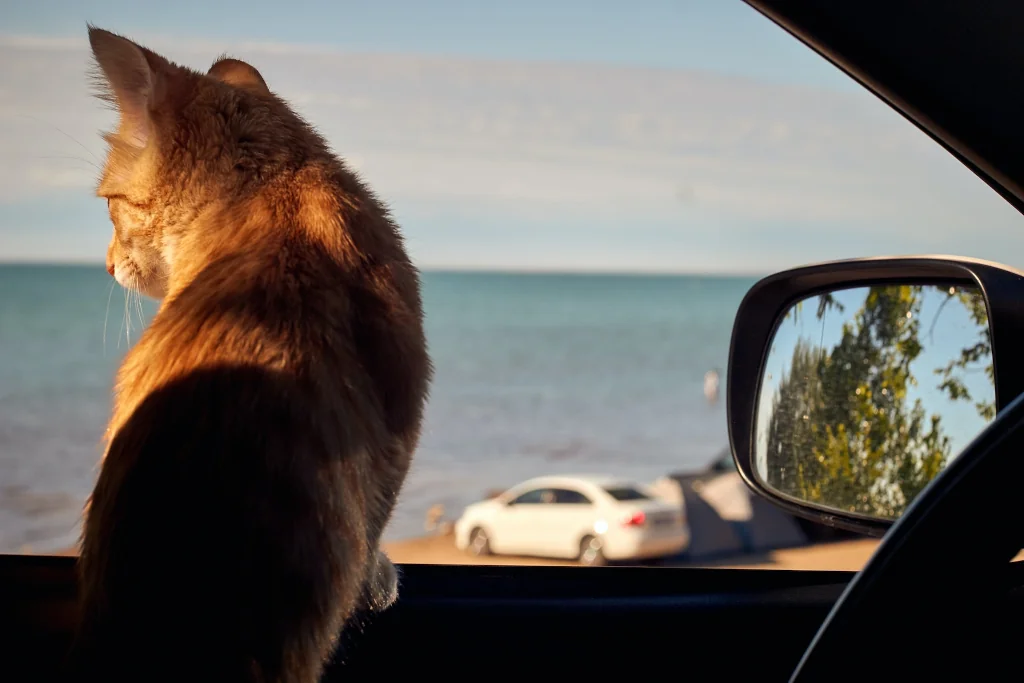Disclosure: We may earn a commission from helpful, relevant links in our content. No cost to you. See our privacy policy.
Embarking on a road trip with your feline friend?
Congratulations on choosing to experience scenic routes and thrilling landscapes from the comfort of your car. It’s a fantastic way to bond and make memories.
However, it’s not without its set of challenges. The constant motion, confined space, and unfamiliar surroundings can be stressful for your furry companion. It’s like having a toddler on board, only furrier and with sharp claws. I get it. I’ve been there, too.
But I’ve got you covered. In this guide, we’re going to share tips, secrets, and strategies to make your long car ride with your cat as smooth as possible. Whether you’re on the road for 12 hours or simply going for a long drive, these tips will come in handy. Buckle up, and let’s get started!

How to Prepare Your Cat for a Long Car Ride?
Preparing your cat for a long car ride is a lot like prepping a human – you need to address their comfort, safety, and needs, and sprinkle in a little entertainment.
Begin with Carrier Introduction. Start early by helping your cat get used to their carrier. Leave it open in their favorite spot, toss in some comfy bedding, and add their favorite toys. Let them explore it at their own pace. This helps to create positive associations with the carrier.
A Trial Run Can Help. Before you embark on a long journey, consider a few shorter trips to help your cat acclimate to the car ride experience. Start with a quick drive around the block.
Visit the Vet. Ensure your cat’s vaccinations are up to date, and that they comply with legal requirements (more about this in our cat travel vaccination guide). In addition, if your kitty gets carsick, your vet can prescribe medication to help with motion sickness.
Get a Pet-Friendly Map. If you’re planning a long trip, there might be places you’ll stop for a break that may not be pet-friendly. To avoid any hassle, consider getting a pet-friendly map, an underrated tool that outlines pet-friendly restaurants, parks, and hotels along your route. Websites like PetsWelcome can help you here.
Pack a Comfort Kit. Pack a small kit with your cat’s favorite blanket, toys, and a piece of clothing with your scent on it. The familiarity of these items can help soothe your cat and make them feel safe in the unfamiliar car environment.
Remember, a little preparation can go a long way in ensuring a stress-free journey for both you and your cat.
Essential Items for a Cat’s Car Journey
Packing the right items can make a world of difference for your cat’s comfort and safety during the journey. Here’s a handy list of items you shouldn’t leave without:
- The Carrier. Your cat’s home-away-from-home, the carrier, is the most critical piece of equipment. Make sure it’s well-ventilated and securely fastened in the car. The Petmate Two Door Top Load carrier is a top choice due to its sturdy build, ample ventilation, and secure latch system. It’s like a traveling home for your cat.
- Water and Snacks. Always carry fresh water and their favorite snacks. Dehydration is a common issue during long trips, so frequent water breaks are essential. The Lixit Top Fill Water Bottles are excellent for providing fresh water throughout the trip.
- Litter Box. A portable, easy-to-clean litter box is a must. Look for one that’s leak-proof and easy to pack away when not in use. Consider the PetSafe Disposable Cat Litter Box, which is compact, leak-proof, and easy to clean.
- First Aid Kit. This should include basic first aid items and any medication your cat takes regularly. Don’t forget the motion sickness meds if your kitty gets queasy on the road. The AKC Pet First Aid Kit includes most basic first aid items, including antiseptic wipes, gauze, and a pet safety guide.
- Comfort Items. Your cat’s favorite blanket or toy can provide a sense of familiarity and security in an otherwise unfamiliar environment.
- Identification. An updated ID tag and a microchip are crucial in the rare event that your cat somehow escapes from the car or carrier. The GoTags Personalized Cat Collars allow you to engrave your contact info directly onto the collar.

How to Handle Pit Stops with Your Cat?
You might think pit stops are nothing special, but if you don’t pay attention, your precious furball might easily get into a dangerous situation.
First, keep the carrier secure even during breaks as sudden freedom can cause them to bolt or hide in unfamiliar places.
Whenever you exit the vehicle, ensure windows are securely shut, and doors are closed to prevent accidental escape. Use these breaks to offer water and a chance to use the litter box inside the car.
Do not let them roam outside unless they are leash-trained and even then, only in safe, quiet areas.
What About Night Travels, Any Tips?
Night travels can be a game-changer, especially for cats who are nocturnal by nature.
Here’s a tip you might not have heard before: use a nightlight in the carrier. It provides just enough illumination for your cat to see without being as disturbing as the car’s interior light.
One night, during our trip across the state, I noticed my cat, Smokey, growing increasingly anxious as the darkness fell. The usual soothing words didn’t work. Then it struck me: back home, he never had to deal with absolute darkness; we always had a little nightlight on.
I quickly plugged a small, battery-powered nightlight into the car’s USB port, and put it near his carrier. The change was immediate. Smokey settled down and seemed to draw comfort from the soft glow. It was a simple solution, but it made our night journey significantly more peaceful.

Key Tips for Comfort and Safety on the Road
Once you’ve packed your cat’s essentials, here are some pointers to ensure your cat is comfortable and safe during the journey:
Drive Smoothly. Cats are sensitive to motion, so avoid sudden starts, stops, or sharp turns whenever possible. Smooth, consistent driving can help ease your cat’s nervousness.
Secure the Carrier. Make sure the carrier is fastened securely. It shouldn’t slide or move around when you’re driving. Place it in a spot where your cat can see you, as your presence can have a calming effect.
Keep Temperatures in Check. The temperature inside your car should ideally be kept between 70-75°F (21-24°C), a comfortable range for most cats. Overheating can be harmful to cats or any other pet, so use the air conditioner if needed, and avoid parking in direct sunlight. Temperatures get high really fast if you leave your car in the sun.
Related: Do cats like Hot or Cold weather?
Stick to the Schedule. Maintain your cat’s routine as much as possible, including feeding and litter box times. This will help them stay relaxed and reduce stress.
Noise Control. Keep the noise level down. Loud music or road noise can stress your cat. If they seem agitated, consider playing soft, soothing music to help calm them down. There are many sounds you can play to calm your cat.
Unique Tip – Talk to Your Cat. Yes, you read that right. Cats find comfort in familiar sounds, and your voice is one of them. Talk to them during the ride, reassure them, and let them know they are safe. If you find that boring, talk to someone else or just sing to yourself.
Remember, the journey is just as important as the destination, especially when it comes to the well-being of your feline travel companion.
FAQs
Can I feed my cat during the car ride?
While feeding your cat during the car ride, ensure it’s done in small portions to prevent nausea. It’s advisable to stick to their regular diet to avoid any digestive upsets.
What if my cat doesn’t like being in a carrier for so long?
If your cat doesn’t enjoy being in a carrier, consider conditioning them with short trips before your long journey. Also, make the carrier comfortable with familiar scents, toys or blankets.
How often should I stop for breaks on a long car journey?
For a 12-hour car journey, ideally, you should take breaks every 2-3 hours. This would provide your cat with opportunities to drink water and use the litter box.
What should I do if my cat gets carsick?
If your cat gets carsick, consult with your vet before the journey. They can recommend motion sickness medications suitable for cats. During the ride, keep the car well-ventilated and maintain a smooth driving style to reduce nausea.
Alex, a passionate animal lover, has experience in training and understanding animal behavior. As a proud pet parent to two dogs and three cats, he founded AnimalReport.net to share insights from animal experts and expand his knowledge of the animal kingdom.




